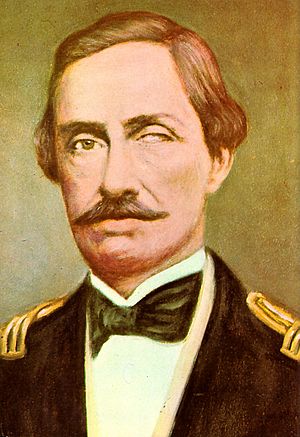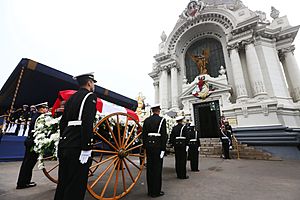Manuel Villar Olivera facts for kids
Quick facts for kids
Manuel Villar Olivera
|
|
|---|---|
 |
|
| Born | March 30, 1801 Lima, Viceroyalty of Peru, Spain |
| Died | October 6, 1889 (aged 88) Callao, Peru |
| Allegiance | |
| Branch | |
| Years of service | 1820 — 1881 |
| Rank | Rear Admiral |
| Commands held | Commander of the Peruvian-Chilean Allied Squad (1866) |
| Battles/wars | Peruvian War of Independence
Gran Colombia–Peru War
Salaverry-Santa Cruz War
|
Manuel Villar Olivera was a brave Peruvian Rear-Admiral. He was born on March 30, 1801, and lived until October 6, 1889. He served in the Peruvian navy for a very long time. His career started during the Peruvian War of Independence and lasted until the War of the Pacific.
He is most famous for leading the combined Peruvian and Chilean navy. This happened during the Battle of Abtao in 1866. In this battle, his forces faced the Spanish fleet during the Chincha Islands War.
Contents
Early Life and Training
Manuel Villar Olivera was born in Lima, the capital city of what was then the Viceroyalty of Peru. His father, Pascual Villar, was an artillery colonel in the Spanish army. His mother was Agustina Olivera.
Manuel began his studies to become a sailor at the Royal Nautical Academy of Lima. In 1819, he joined the navy as a midshipman. This was his first step toward a long naval career.
Fighting for Independence
In 1820, Manuel Villar joined the army that was fighting for Peru's freedom. This army was led by General José de San Martín. Villar followed the orders of Lord Cochrane. He took part in a very important battle called the Capture of the frigate Esmeralda. The Esmeralda was the strongest Spanish ship in Callao.
After this, Villar became part of Peru's new navy. He served under Martín Guisse, a British officer who had fought in the famous Battle of Trafalgar.
After Peru won its independence from Spain, Villar continued his naval service. He joined the northern naval campaign during the Gran Colombia–Peru War. He was part of the crew on the frigate Presidente, still under Guise's command.
Blockade of Guayaquil
Villar showed great bravery during the fighting in the Guayaquil Blockade. His actions helped force the port to surrender in 1829. Because of his excellent service, he was promoted to lieutenant of a frigate. In 1834, he was promoted again to second lieutenant.
Supporting Salaverry
In 1835, he supported General Felipe Santiago Salaverry in a war against Andrés de Santa Cruz. Salaverry was defeated and later executed. Many officers, including Villar, were removed from the military. However, Villar was soon allowed to rejoin the navy. He then served the Peru-Bolivian Confederation on ships like the brig Flor del Mar and the corvette Socabaya.
Time in Merchant Marine
When the Confederation ended in 1839, Villar was again removed from service. He then worked in the merchant marine until 1847. During this time, he sailed to places like China, Australia, and Brazil.
Exploring the Amazon
In 1853, President José Rufino Echenique sent Villar to the United States. His job was to oversee the building of two river steamers, the Tirado and the Huallaga. He brought these ships back to Peru by sailing through the mouth of the Amazon River in 1854. He then helped explore the Peruvian Amazon region. After a battle in 1855, President Echenique was overthrown. Villar was once again separated from the navy.
Chincha Islands War
Villar rejoined the navy when Spanish ships became a threat to Peru. He became the commander of the Peruvian naval division. This group included the frigates Apurímac (his ship) and Amazonas. It also included the corvettes América and Unión.
On February 7, 1866, his fleet, allied with two Chilean ships, fought the Spanish frigates Villa de Madrid and Blanca. This battle was called the Battle of Abtao. The South American allies saw it as a victory because the Spanish ships left without breaking their defense. The Peruvian government honored Villar, calling him a "Hero of the Homeland."
In the years that followed, he helped review and improve naval rules and regulations.
War of the Pacific
When the War of the Pacific started, Manuel Villar was 78 years old. Despite his age, he asked to be given command of Fort Santa Rosa in Callao. In January 1880, he was made Secretary of the Navy by the government of Nicolás de Pierola.
He helped prepare for the defense of Lima. On January 5, 1881, he was promoted to Rear Admiral. During the Battle of San Juan and Chorrillos on January 13, 1881, he was in charge of the Morro Solar batteries. He fought there until the very last shot was fired.
Later Life and Legacy
After the war, Manuel Villar retired from public life. He passed away in Callao in 1889.
His remains were first buried in the Presbítero Maestro Cemetery. However, on June 1, 2017, his remains were moved to the Crypt of the Heroes. This special place is also in the Cementerio Presbítero Matías Maestro. A ceremony was held with important military and government officials, as well as his family.
See also
Template:Kids robot.svg In Spanish: Manuel Villar Olivera para niños


